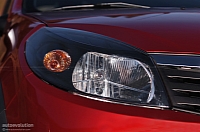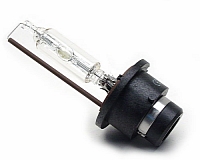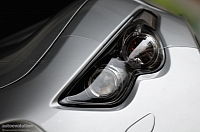Which are the Best car headlights that you should use?
Halogen Headlamps
Halogen headlights are currently the most popular in the automotive world and, in case you’re wondering why this happens, it’s mostly because of their primary advantage: they’re simple and cost-effective.
A halogen light bulb has a lifetime of about 1,000 hours under normal conditions, while replacement costs are usually very low comparable to the other types below (around 30 bucks for a decent set).
However, halogen bulbs are becoming the second option for more and more car companies worldwide. The reason? Halogen isn’t exactly synonymous with efficiency and, to better understand why, we’ll explain how such a light bulb works.
First of all, it is made of a glass envelope capable of resisting very high temperatures, plus a gas, usually a combination of argon and nitrogen, along with a tungsten filament. To create light, the tungsten filament receives electricity from the car’s battery and heats up to around 2,500 degrees Celsius thus starting to glow (incandescence process).
When the halogen light bulb comes to the end of its lifetime, it usually happens so because the tungsten in the filament evaporates and leaves the filament, getting deposited on the glass and causing the filament to rupture at some point and render itself unfunctional.
But that’s not the major issue, though. The biggest problem is that, while generating the radiating light, the bulb also creates a large amount of heat which represents wasted energy.
Another major problem with halogen bulbs is also the way they react to various substances. For example, when replacing a faulty bulb, it is mandatory to avoid touching the glass of the spare one! The grease on your fingers will stick to the quartz glass, causing it to heat unevenly and drastically cut the bulb’s life. It you touch it, try using a clean cloth and an alcohol-based substance to rub it off.
Still, halogen light bulbs have several advantages that could make them the number one option for most carmakers: they create a decent illumination for the least amount of money; they come in several different sizes, which means that such bulbs can be installed on most car models; they are dimmable, thus allowing carmakers to build multiple versions, depending on body type and dimensions.
In just a few words, there are the pros and cons of halogen headlamps:
Advantages:
-
- Easy to replace
- Simple construction
- Different dimensions
- Cost-effective
Disadvantages:
-
- Energy wasting
- Extra care required
Hid Headlamps (Xenon Headlights)
Xenon headlights, officially known as high-intensity discharge headlamps (HIDs), are usually defined as a more efficient solution, mostly because of the colour temperature and the amount of light they generate.
The first xenon headlight appeared on the BMW 7 Series in 1991 and slowly became the number one option for several car companies, which avoided however to offer it as standard equipment.
HID lights work pretty much like your neon tube in the basement. You have an enclosed tube filled with gases, an electrode at each end and an electric current passing through. In vehicle applications, HID lamps use a transparent quartz housing, tungsten electrodes and a mix of gases that get stimulated by the high-voltage electric current passing between the two electrodes.
Despite their commonly used name, HIDs use a metal-halide mix and rely on xenon gas only during start-up. That’s because one of the main problems with HID lamps is the amount of time needed for the gases inside to reach their operating temperature and provide a strong light.
The process of lightning up HID lamps happens in three steps: first comes the ignition phase, when a high voltage pulse produces a spark that ionizes the xenon gas and creates a tunnel of current between electrodes.
The temperature in the bulb rises quickly vaporizing the metallic salts which lower the resistance between the two electrodes; ultimately, the ballast switches to continuous operation supplying the lamp with a continuous amount of power so that the electric arc won’t flicker.
Pluses? First of all, a xenon headlight is much more efficient when it comes to the amount of produced light as compared to the halogen ones. Of course, this can be easily considered a major setback, especially from the point of view of incoming traffic, if the angle of illumination isn’t properly configured (mostly when aftermarket kits are installed the wrong way or using headlight cases that were not designed for HIDs).
According to official stats, a xenon bulb produces 3000 lumens and 90 mcd/m2, while a halogen light generates 1400 lumens and 30 mcd/m2.
Of course, xenon lamps have slowly become available in many sizes and versions, especially to be used on various types of cars.
Another big plus comes because xenon lights have a pretty long lifetime, exceeding the one of halogen lamps: estimates are pointing to an operation life of around 2,000 hours in normal conditions.
Efficiency might be another advantage when thinking about choosing HID detrimental to halogen lights. They do use more power to kickstart into action, but after they’ve reached operating temperature, they’ll use less power than standard bulbs.
This means there will be a slightly smaller load on the alternator which won’t require more engine torque to sustain the electricity demand. However, you’ll barely see any difference in fuel consumption (maybe one fluid ounce per hour) but it’s nice to know if you’re a “greenhead”.
Setbacks? Well, they’re going to cost more than halogen lights (including maintenance) and are more complex, since they require a device called ballast, which is a capacitor that creates and regulates the high voltage needed by the HIDs to operate.
Let’s not forget these lights need a few seconds to reach full brightness, reason why they are not as good as separate high beams. Some cars use HID low beams and separate standard bulbs for high beams.
On higher-end models, the same HID unit works both ways (wrongly named bi-xenon) by using a mechanical shade inside the reflector to change the beam’s direction accordingly.
Some xenon headlamps could also hurt our health, as certain versions could contain toxic substances, such as metal mercury. Some countries have imposed special regulations that prohibit the use of such substances but, of course, this will only lead to higher production and repair costs.
Ultimately, the amount of glare generated by the headlamps might be extremely disturbing for the other drivers on the road, especially for incoming traffic, thus raising the number of accidents and fatalities caused by other than speed and technical problems.
So, to review the pros and cons of xenon lights:
Advantages
• Longer lifetime than halogen lights
• More efficient than halogen as they use less power and create more light
• Better visibility for the driver
Disadvantages:
• Too much glare and thus, potential problems for the incoming traffic
• High costs
• More complex system than halogen bulbs
• Possible harmful materials could be used
• They take a few seconds to reach full brightness
Led Headlamps
The automotive industry has evolved a lot, that’s for sure. Along with it, headlamps have reached another level and, after carmakers closely analyzed the way halogen or HID lights influence their models, turned to another option: LEDs. At least on paper, LEDs seem to be the solution for mass-produced cars but several setbacks could change the world’s perspective over this type of technology.
The working principle of an LED is quite hard to explain, but in short words, they rely on negative electrons moving against positive “holes” across a semiconductor. When a free electron falls into a hole that sits on a lower energy level, it will lose its energy which is released as a photon (the tiniest fraction of light) in a process called electroluminescence.
Multiply this process a thousand times per second and you have a continuous bright light being emitted from something about 2 mm wide – a light-emitting diode (LED).
The most important aspect when it comes to LED headlights is the fact that they need very low power to work compared to classic halogen bulbs. LEDs are for instance used on Toyota Prius models and on a couple of other hybrids on which electricity plays a key role – not necessarily for the headlights. The first production units were to be found on the 2004 Audi R8.
Generally speaking, LED headlights are stacked in between the halogen and HID lamps regarding their luminescence, but they provide focused rays and can also be played with to create different shapes.
Also, thanks to their small size, LEDs allow for great manipulation, with manufacturers being able to create all kinds of shapes and assemblies that would perfectly match their models, so no more ugly dome reflectors.
There are some issues to be clarified, however. For example, although LEDs do not emit heat as they light up, like halogen headlights for example, they do create a certain amount of heat at the bottom of the emitter (mainly the chip) when the electricity passes through, thus creating a potential risk for adjacent assemblies and connectivity cables. Reason why LED headlamps need cooling systems, like heat sinks or fans to keep them from melting.
Oh, and let’s not forget that these cooling systems are located in the engine bay, a not-that-cool area for some other system to maintain a decent temperature. The reason why, LED headlights are also harder to design and implement in a car, thus more expensive than HIDs.
Why aren’t LED daytime running lights or LED taillamps using heat sinks? Simply because nobody relies on them to navigate in the dark. Thus they don’t need to be as powerful as headlights, meaning that the current run through the chips won’t be enough to pose that much of a heating problem.
To wrap it up with the LED headlights:
Advantages:
• Small size, allows great manipulation for various shapes
• Very low energy consumption
• Brighter than halogen headlights while still offering a warmer light than HIDs
Disadvantages:
• High production costs
• High temperature created around adjacent assemblies
• More difficult to design and cope with the already high engine bay temperatures














